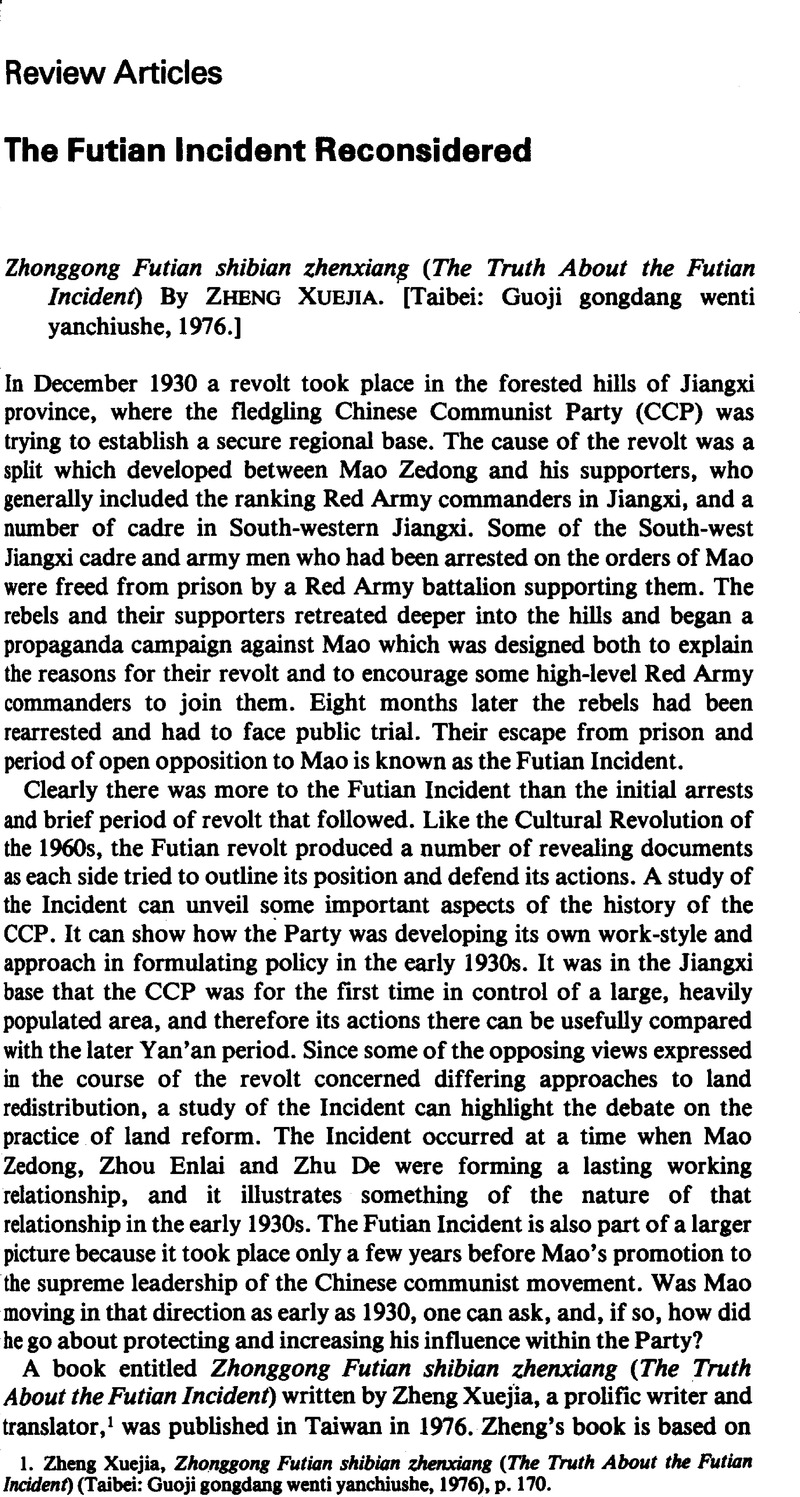Article contents
The Futian Incident Reconsidered
Published online by Cambridge University Press: 17 February 2009
Abstract

- Type
- Review Articles
- Information
- Copyright
- Copyright © The China Quarterly 1982
References
1. Xuejia, Zheng, Zhonggong Futian shibian zhenxiang (The Truth About the Futian Incident) (Taibei: Guoji gongdang wenti yanchiushe, 1976), p. 170.Google Scholar
2. The Chen Cheng papers are known as the Shishou ziliaoshi gongfei ziliao (Shishou Collection of Materials on the Communist Bandits), and have been microfilmed in Taibei on 21 reels. Jianmin, Wang, Zhongguo gongchandang shigao (Draft History of the Chinese Communist Party) (Taibei, 1965), 3 Vols.Google Scholar
3. Guotao, Zhang, Wode huiyi (My Memories) (Hong Kong: Mingbao yuekan chubanshe, 1971), 2 Vols.Google Scholar An English language version of these memoirs, not merely a translation, is Kuo-t'ao, Chang, The Rise of the Chinese Communist Party (Lawrence, Kansas: University Press of Kansas, 1971), 2 Vols.Google ScholarSmedley, Agnes, The Great Road: The Life and Times of Chu Teh, New York, 1956.Google Scholar Zheng also used Zhongguo gonggchandang zhi toushi (The Chinese Communist Party in Perspective), a 1935 collection of CCP documents obtained by the Guomindang, reprinted in Taibei: Wenxing shudian, 1962.
4. See Suleski, Ronald, “The Fu-t'ien Incident, December 1930,” in Suleski, Ronald and Bays, Daniel, Early Communist China: Two Studies (Ann Arbor: Center for Chinese Studies, University of Michigan, 1969.Google Scholar Michigan Papers in Chinese Studies, No. 4). Some of the works used by Zheng which I did not use in my study of the Incident are: Gong Chu, “Canjia zhonggong wuzhuang toujeng jishi” (“A record of joining in the Chinese Communist armed struggle), Mingbao yuekan (January 1973); Zhongguo gongchandang zai Jiangxi dichu lingdao geming toujeng de lishi ziliao (Historical Materials on the Chinese Communist Party's Leadership of the Revolutionary Struggle in Jiangxi) (n.p.: Jiangxi renmin chubanshe, 1958), which reprints some CCP documents from the 1930s; Dadao dayinmoujia dayexinjia dajunfa Peng Dehuai (Strike Down the Plotter, Madman and Warlord Peng Dehuai), a booklet published in Beijing by the Qinghua daxue jingganshan bingtuan, a Red Guard group at Qinghua University, in 1967.
5. Zheng, , Zhonggong Futian, pp. 41–43.Google Scholar English translations of many documents concerning land redistribution can be found in Hsiao, Tso-liang, The Land Revolution in China, 1930–1934: A Study of Documents (Seattle and London: University of Washington Press, 1969).Google Scholar Many of these issues are also presented in Boyi, Cao, Jiangxi suweiyi zhi jianli ji chi pengguei (The Rise and Fall of the Chinese Soviet in Jiangxi) (Taibei: Guoli zhengji daxue dongya yanjiusuo, 1969), see esp. Chap. IV.Google Scholar
6. See Rue, John E., Mao Tse-tung in Opposition, 1927–1935 (Stanford, California: Stanford University Press, 1966), p. 201.Google Scholar Zheng has cited Rue in several places in his book.
7. Zheng, , Zhonggong Futian, pp. 49–50Google Scholar; Suleski, , “The Fu-t'ien Incident,” p. 11.Google Scholar
8. Zheng, ibid. pp. 56–58, 64, 68.
9. Some of Zheng's information was from an unnamed source (see p. 5). In this section he also used Tianfang, Cheng, Cheng Tianfang zaonian huiyilu (Memoirs of the Early Years of Cheng Tianfang) (Taibei: Chuanji wenxue chubanshe, 1968).Google Scholar
10. Zheng, , Zhonggong Futian, pp. 70–71, 89.Google Scholar
11. Contrast the analysis given in Zheng, ibid. pp. 92–95 and Suleski, , “The Fu-t'ien Incident,” p. 11.Google Scholar As suggested by an unnamed reader for The China Quarterly, the AB Corps charge may have been used sparingly because it lacked credibility to start with, or because after January 1931 the Mao group could invoke Li Lisan's indictment against Mao's local rivals.
12. Out of the 72 top cadre in Jiangxi identified by Zheng, only seven are listed as having been charged with membership in the AB Corps (see Zheng, , Zhonggong Futian, p. 27Google Scholar). In addition, the total number of cadre and military men to have been executed because of suspected AB Corps activity varies widely. In one place Zheng lists 1,500 people (p. 89), while the appendix (see note 14 below) claims well over 5,200 were killed (see ibid. p. 146). Zheng assumes that any cadre captured was executed, but my study shows that some were held in prison for several years (Suleski, , “The Fu-t'ien Incident,” p. 13).Google Scholar
13. Zeng's account is based on a Chinese language translation of the book: Vladimirov, Peter, The Vladimirov Diaries, Yenan, China; 1942–1945 (Garden City, New York: Doubleday, 1975).Google Scholar In the book Vladimirov quotes at length from three documents relating to the Futian Incident which came into his possession in 1943. They furnish many interesting details, although the authenticity of all that is said is open to question; see pp. 167–78. Also see Zheng, , Zhonggong Futian, pp. 76–77Google Scholar; Suleski, , “The Fu-t'ien Incident,” p. 4.Google Scholar
14. As an appendix, Zheng has reprinted a chapter on the Futian Incident taken from a book by Shengchang, Cheng, Chichu chuwenti pipan (A Criticism of Several Problems in the Red Areas)Google Scholar, originally published in October 1935. This appendix mentions the Huangpo Incident, but says it involved only armymen and was not the incident in which the Action Committee cadre were arrested. See Suleski, , “The Fu-t'ien Incident,” pp. 3–5Google Scholar; Zheng, , Zhonggong Futian, p. 78.Google Scholar
15. See Suleski, , “The Fu-t'ien Incident,” pp. 8–9.Google Scholar Zheng was quoting from Guo Hualan, Zhongguo gongchandang shilun, and the English language version of this book is Kuo, Warren, Analytical History of the Chinese Communist Party (Taibei: Institute of International Relations, 1968–1971), 4 Vols.Google Scholar This book covers the AB Corps issue in Vol. II, pp. 298–357. Also see Zheng, , Zhonggong Futian, p. 95.Google Scholar
16. Suleski, , “The Fu-t'ien Incident,” p. 13.Google Scholar
- 1
- Cited by


